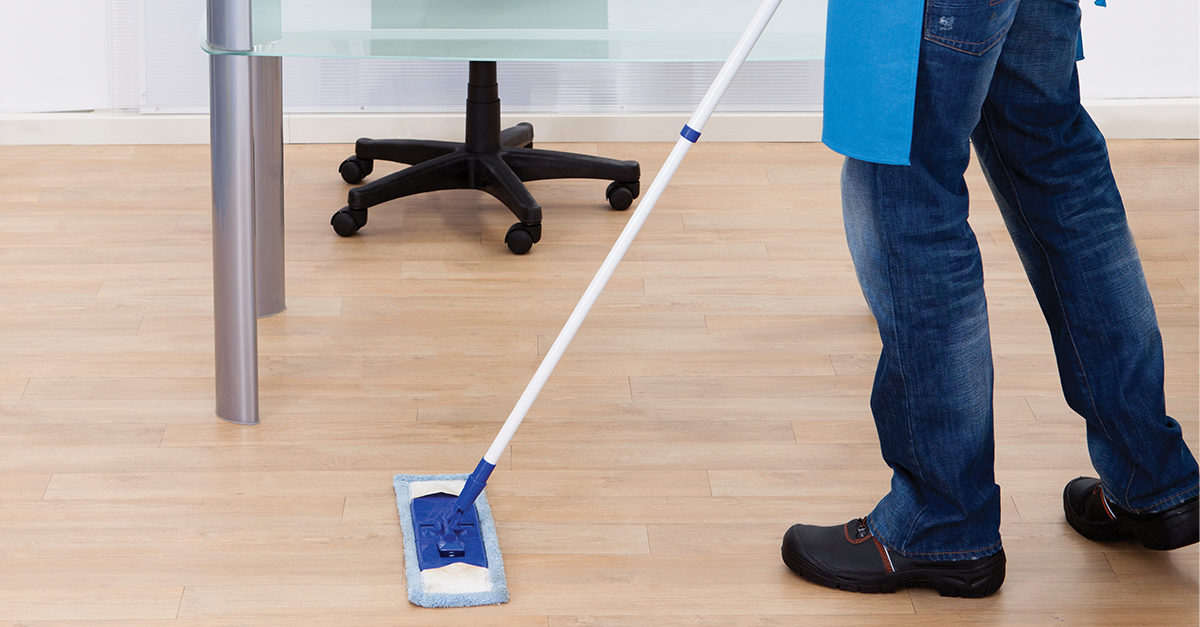Many facilities these days are getting away from traditional flooring such as vinyl composition tile, also known as VCT. This departure, often spurred by sustainability initiatives, architectural and design artistry, or a combination thereof, can present challenges to cleaning professionals using older methods.
In this article, we shall look at some basic technical maintenance for different types of floors, including bamboo, cork, linoleum, and laminates.
Bamboo
Bamboo has been described as “the other hardwood,” which is interesting since bamboo is actually considered a member of the grass family. Bamboo is a hardy plant and has been used for construction in some parts of the world for thousands of years. However, when it comes to flooring in a commercial setting, bamboo may not be the best choice.
Despite varying degrees of hardness, bamboo usually does not fare well when subjected to foot traffic, especially consisting of high-heeled shoes. This type of damage cannot be repaired by your floor crew.
And therein lies the rub: About the only thing we can do to maintain bamboo flooring is to keep it clean. Once the floor is damaged, there is no turning back. The layer of bamboo is not thick enough to sand it down to expose a new layer.
Cleaning bamboo is best accomplished with microfiber flat mops and a small amount of cleaning agents. Most manufacturers will specify their own brand of cleaner, but a check of the safety data sheets, or SDSs, will usually reveal their cleaner is nothing more than a neutral floor cleaner. Proper dilution in cool water and a limited amount of moisture is key.
Cork
Cork is another wood product that is rapidly renewable, meaning once cork is harvested, it can be harvested again from the same tree within just a few years. This renewability has rekindled interest in cork flooring.
Cork is softer and quieter than other types of flooring, and it should not be used in wet areas. Manufacturers may have a different opinion about this because they have sealed the cork at the factory or as part of the installation process. Applying traditional floor finish is not recommended, because the hard finish may crack under normal traffic due the softness of the cork.
I recently stayed in a hotel that had cork flooring in most of the rooms. It was evident that moisture had gotten under the cork tiles, because they were starting to come up where they met the bathroom ceramic.
Depending on the brand, you may be able to reapply the factory coating in the field, but most of the time it is not recommended. Again, microfiber, neutral cleaner, and limited moisture are your best option.
Linoleum
Linoleum is another flooring type that was once very popular, waned, and is now making a strong comeback. The ability to mix and match colors to create artistic appearances has made this a favorite in health care and educational settings.
Proper care is key for maintaining linoleum floors. High-pH cleaners and stripping chemicals can cause harm that may not be reversible. Proper care is often rooted in neutral cleaners and nothing more aggressive than a red cleaning floor pad. Newer versions do not require a finish, since this is handled at the factory.
When properly installed, linoleum floors are virtually watertight. When buckling is found along seams and edges, it is usually more of an installation issue than a cleaning issue.
Laminates
Laminates come in many versions and can take on many different appearances. Some of the more common laminates will look like hardwood, stone, or vinyl, among others. Depending on the manufacturer, the flooring may be made from wood pieces or particles, vinyl, and other components that are layered together to achieve strength of the product. Some laminates with a wood-like appearance may be actual strips or pieces of wood, or could be no more than a picture of wood grain glued to the substrate.
Aggressive chemistry or floor pads can again cause irreversible damage to laminates; once the top layer has been scratched, gouged, or otherwise damaged, there is no turning back. With a traditional wood floor, you might be able to sand down the floor and recoat it to restore the appearance. With laminates, however, the surface may only be as thick as a sheet of paper, and does not provide any material to sand.
Preventative Measures
As you may have noticed by now, aggressive cleaning for the types of floors listed in this article is not recommended and may have you paying for a new floor. In regards to cleaning, the most important thing you can do is to prevent soil by using an adequate matting program and to quickly remove dry soils that appear. Remember: Most scratches originate from dry soil.
Vacuuming with an appropriate floor tool will often yield the best results. Since aggressive cleaning processes are rarely a good idea, it is critical that your daily program be on point.
When caring for a fragile floor, the best defense is to know what floor you have and follow the manufacturer’s procedures. This isn’t always easy, because oftentimes, people forget the brand or call one floor by another name.
If a new floor is being installed in your facility, see if you can get the label off of the box or take a picture of the label so you will have a reference for the future.
Above all else, if things start to go wrong with your floor, stop and seek help form your distributor, the floor manufacturer, or installer. Traditional VCT techniques will generally cause more harm than good.
Bill McGarvey is the director of training and sustainability for the Philip Rosenau Co., a janitorial and sanitary maintenance distributor. Bill has more than 35 years of experience in the cleaning industry, and has numerous training and standardization certifications from ISSA, the worldwide cleaning industry association, which includes serving as a master trainer for the Cleaning Management Institute’s Custodial Technician Certification Program. He can be contacted at[email protected].



